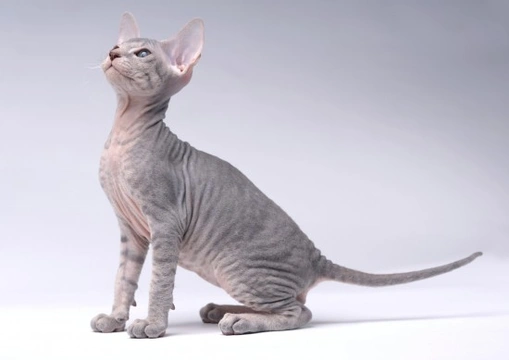
Is a Peterbald the right choice of cat for you?
The Peterbald is a hairless cat breed that hails from Russia, and has only relatively recently become recognised as a breed in its own right. Their name comes from a combination of their origin- St. Petersburg-and the fact that they are hairless, or bald!
The breed was only created during 1994, when a male Don Sphynx cat was bred with a female Oriental Shorthair cat, and the resulting litter produced four kittens that formed the first four founders of the Peterbald breed. The Peterbald was recognised in Russia as a breed in its own right in 1996, and by TICA (The International Cat Association) in 1997.
The breed has a rather Siamese or Oriental look to it, with a sleek, lithe body and long legs, large, widely set ears, and a long muzzle. Acceptable outcrossings for the Peterbald include the Siamese and Oriental cat, which has further influenced the appearance of the Peterbald’s gene pool.
If you are intrigued by hairless cats and are wondering if the Peterbald is the right choice of pet for you, in this article we will look at some of the most commonly asked questions about the breed in more detail. Read on to learn more!
Why is the Peterbald hairless?
The Peterbald possesses a gene mutation that causes the cats to lose their hair, and at birth, Peterbald kittens may be either bald or flocked, which means that they have a fine, velour-like covering of hair. They may also be born with straight or curly coats that are almost normal. Cats of the breed born with fur may still lose their fur as they age, due to the gene mutation.
What are their temperaments like?
The Peterbald is an incredibly sweet natured and affectionate cat that can be quite demanding when it comes to asking for attention! They are very vocal and may meow for all sorts of reasons, including because they just feel like making a noise! They are apt to bond strongly with all of their family, and will often follow individuals around the house looking for attention. They do not like to be left on their own for long periods of time, and do not like to be left out of what is going on in the home!
They are also intelligent and lively cats, and enjoy mock-hunting play, climbing, and playing with toys. They are very entertaining to watch, and are always ready for a game! Interestingly, the Peterbald has large, oval paws with webbed toes, which give them an advantage when it comes to gripping onto things!
Are they hard to care for?
Due to their lack of fur, the Peterbald requires more attention to be paid to their general care than most other types of cats. They are often kept as indoor only cats as they will become too cold in the winter and be prone to sunburn in the summer, although cat jumpers and t-shirts can help with these problems! Helping your cat to maintain its body temperature at a comfortable level is an important part of ownership, and they do tend to very much feel the cold.
Like all hairless cat breeds, the Peterbald tends to get an oily film across their skin as the naturally produced skin oils are not distributed throughout the fur in the normal way. This can build up to clog the pores of the skin and lead to spots, irritations and problems. It is advised to bathe the Peterbald cat on a regular basis, in some cases as often as weekly, in order to clear the oil build up. Unlike most cats, hairless breeds tend to be perfectly happy to be bathed, and often actively enjoy it!
Are they healthy?
As a very recently created breed, there are no formal figures held as yet on the longevity and general health of the Peterbald cat. As a breed that was created from the crossing of two other unrelated breeds and with input from various other breeds too, the Peterbald benefits in some ways from the advantages of hybrid vigour and a mixed heritage.
The hairless nature of the cat does mean that it may be prone to skin problems if not bathed and groomed regularly, and also, they are very susceptible to sun burn, and also potentially cancers of the skin from too much sun exposure.
The gene that leads to hairlessness in the Peterbald cat is also thought to be connected to a condition called feline ectodermal dysplasia, which can cause a range of problems within the cat alongside of their lack of hair. Problems with lactation in breeding queens, and issues with the teeth and mouth such as missing teeth or bad dental formation are all potential issues that can accompany the condition.



